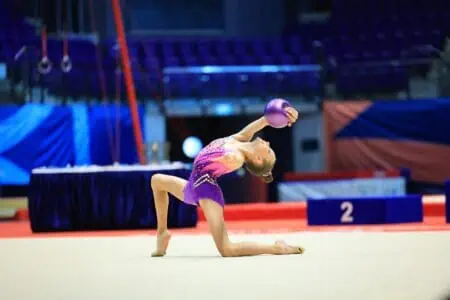We explore the sport’s rich history, its massive popularity in the U.S., and the legendary athletes who redefined what the human body can do.
Whether you are a parent looking to enroll your child, a budding gymnast, or a fan of the Olympic Games, these insights provide a closer look at the gravity-defying world of gymnastics.
Key Takeaways
- Gymnastics roots trace back to Ancient Greece in the fifth century B.C. where it was used for military training.
- In the United States, gymnastics is consistently one of the most-watched events during the Summer Olympics.
- Simone Biles has surpassed historic records to become the most decorated gymnast in history, male or female.
- Elite gymnasts are often shorter than average to maximize their rotational speed and power-to-weight ratio.
40 Gymnastics Statistics and Facts
Gymnastics captures the imagination like few other sports. From the chalk dust of the local gym to the bright lights of the world stage, there is always something new to learn. Here are 40 fascinating facts and statistics covering the sport’s history, popularity, and superstars.
Gymnastics in the U.S.
The United States has become a global powerhouse in the sport. Let’s look at eight statistics defining gymnastics across America today.
- Participation numbers are massive: Approximately 4.27 million people participated in gymnastics across the U.S. in recent years (1). While numbers fluctuate, the sport remains a staple for youth athletic development.
- The Olympic bump: Participation often spikes following a Summer Olympics. The highest participation year on record was 2016, with over 5.3 million participants following the success of the “Final Five” team in Rio.
- A top-tier spectator sport: Gymnastics is frequently the most-watched Olympic sport among American television audiences, often surpassing track and field and swimming in prime-time viewership.
- Collegiate popularity is rising: NCAA Women’s Gymnastics has seen a massive surge in popularity, often selling out arenas and drawing millions of viewers for championship meets on major TV networks.
- Global dominance: The United States Women’s National Team has been a dominant force for over a decade, consistently winning team gold medals at World Championships and Olympic Games (2).
- Top states for talent: California traditionally produces the highest volume of elite-level gymnasts (3). Texas and Illinois follow closely behind as major hubs for high-performance training centers.
- Women lead the demographic: In the U.S., female participants significantly outnumber males. This disparity is evident from youth recreational classes all the way up to collegiate programs, where men’s NCAA programs have unfortunately declined in number.
- Diversity is increasing: Efforts to make the sport more inclusive are working. Scholarship statistics show a rise in gymnasts of color in collegiate programs, increasing representation significantly over the last decade (4).
Gymnastics in the World
While the U.S. is a major player, gymnastics is a global phenomenon with deep roots in Europe and Asia. Here is how the rest of the world stacks up.
- The historic medal leaders: Historically, the Soviet Union holds the record for the most Olympic gymnastics medals (248). Russia and the United States follow, though the U.S. has rapidly closed the gap in recent decades (5).
- China’s dominance: China is a perennial powerhouse, particularly in men’s gymnastics. They consistently produce world champions on apparatuses like the parallel bars and rings.
- The age of athletes is rising: The “teenager” stereotype is fading. The median age of female Olympic gymnasts has risen from 16 in the 1990s to over 21 in recent games, proving women can peak later in their careers (6).
- Oksana Chusovitina’s longevity: A prime example of longevity is Oksana Chusovitina. She has competed in eight Olympic Games, representing the USSR, the Unified Team, Germany, and Uzbekistan, competing well into her 40s.
- Different apparatuses for genders: Men compete on six events (Floor, Pommel Horse, Rings, Vault, Parallel Bars, High Bar). Women compete on four (Vault, Uneven Bars, Balance Beam, Floor).
- Judging has changed: The famous “Perfect 10” scoring system was replaced in 2006 by an open-ended Code of Points. Now, scores are a combination of Difficulty (D-score) and Execution (E-score), allowing totals to go well above 15.
- Japan’s perfectionism: Japanese men’s gymnastics is renowned for its emphasis on execution and form. They have a storied history of winning the team all-around gold, including at the Rio 2016 Olympics.
- Height advantages: The average height for elite female gymnasts hovers around 4’9″ to 5’1″ (7). A lower center of gravity helps with balance and rotational velocity during flips.
History of Gymnastics
From ancient war prep to modern arenas, the history of gymnastics is full of twists and turns.
- Ancient Greek origins: The word “gymnastics” comes from the Greek word gymnazo, meaning “to train naked.” In ancient Greece, men performed exercises unclothed to prepare for warfare (8).
- The Father of Gymnastics: Friedrich Ludwig Jahn, a German educator in the early 19th century, is credited with inventing the parallel bars, rings, high bar, and pommel horse. He is widely considered the father of modern gymnastics.
- The first Olympics: Gymnastics was one of the original nine sports in the first modern Olympic Games in Athens in 1896 (9).
- It used to include rope climbing: Early Olympic gymnastics looked very different. Past events included rope climbing, club swinging, and even a rock lifting competition.
- Women joined later: While men competed in 1896, women were not allowed to compete in Olympic gymnastics until the 1928 Games in Amsterdam.
- The Magnificent Seven: The 1996 U.S. Women’s Team, known as the “Magnificent Seven,” secured the first-ever team gold for the United States. This moment, highlighted by Kerri Strug’s one-footed vault, exploded the sport’s popularity in America.
- Tumbling’s long history: While apparatuses are newer, tumbling and vaulting over bulls have been depicted in art from ancient Crete, dating back thousands of years (10).
- Diplomatic issues: Political tensions have often impacted the sport. For instance, the Soviet Union boycotted the 1984 L.A. Olympics, and the U.S. boycotted the 1980 Moscow Olympics, affecting the medal counts for that era.
Gymnastics Tricks and Skills
Gymnastics combines physics with fearlessness. Here are eight skills ranging from playground basics to the hardest moves in the world.
- Forward Roll: The foundational skill of all gymnastics. It teaches spatial awareness and protects the neck. Every elite athlete started with a simple roll.
- Back Handspring: This is the “gateway” skill for power tumbling. It involves jumping backward, blocking off the hands, and snapping down to the feet to generate speed for flips.
- The Iron Cross: A signature strength move on the rings where the gymnast holds their body vertically still with arms extended straight out to the sides. It requires immense shoulder and core power.
- The Yurchenko Double Pike: Historically performed only by men, Simone Biles brought this vault to women’s competition. It is considered the most difficult vault in women’s gymnastics history.
- The Wolf Turn: A polarizing skill on the balance beam and floor. The gymnast crouches on one leg with the other extended and spins. It is valued highly for its difficulty, though many fans dislike its aesthetics.
- The Moors: Named after Canadian gymnast Victoria Moors, this floor skill is a double-twisting double layout. It is an “I” rated skill, making it one of the hardest tumbling passes in the Code of Points.
- Tkachev: A release move on the uneven bars or high bar. The gymnast swings forward, releases the bar, flies over the top of it in a straddle position, and catches it on the other side.
- The Amanar: A vault style involving a round-off onto the board, back handspring onto the table, and a 2.5 twisting back layout off. It was the gold standard for vaulting for many years.
Famous Gymnasts
These legends pushed the boundaries of human potential and became household names.
- Simone Biles: Often called the GOAT (Greatest of All Time), Biles has won over 30 combined World and Olympic medals (11). She has multiple skills named after her in the Code of Points because she was the first to perform them in competition.
- Nadia Comăneci: In 1976, this Romanian icon did the impossible. She scored the first “Perfect 10” in Olympic history at just 14 years old. Scoreboards weren’t even programmed to display a 10.0, so it showed up as “1.00.”
- Kohei Uchimura: Known as “King Kohei,” this Japanese gymnast is arguably the greatest male gymnast ever. He won back-to-back Olympic all-around gold medals (2012, 2016) and six consecutive World all-around titles.
- Olga Korbut: The “Sparrow from Minsk” captured hearts at the 1972 Munich Olympics. Her daring acrobatics and charisma popularized gymnastics for a global television audience.
- Larisa Latynina: Before Michael Phelps, Latynina held the record for the most Olympic medals by any athlete in any sport (18). She dominated for the Soviet Union in the 1950s and 60s.
- Mary Lou Retton: In 1984, Retton became the first American woman to win the Olympic all-around title. Her infectious smile and power vaulting made her an American cultural icon and the first female athlete featured on a Wheaties box.
- Vitaly Scherbo: At the 1992 Barcelona Olympics, Scherbo won six gold medals, including the all-around title. This remains one of the most dominant single-Olympic performances in history.
- Svetlana Khorkina: Known as the “Queen of the Bars,” Khorkina was unusually tall for a gymnast (5’5″). She used her height to create beautiful lines and innovative moves, winning three all-around World titles.
FAQs
In Conclusion
Gymnastics is more than just backflips and medals. It is a discipline that teaches resilience, body awareness, and the value of hard work. From the playground to the podium, the sport continues to evolve, pushing the boundaries of physics and human capability.Whether you are tuning in to watch the next Olympic Games or signing your toddler up for their first tumble class, you are participating in a tradition that spans thousands of years.










